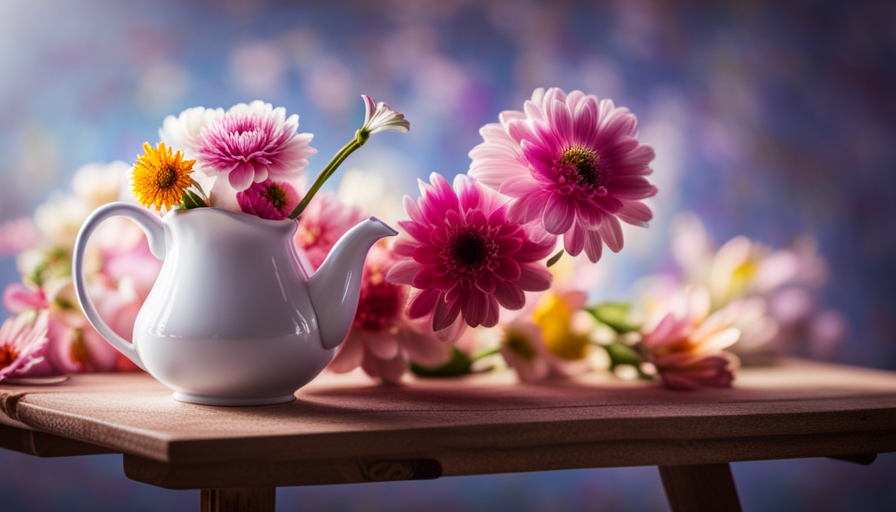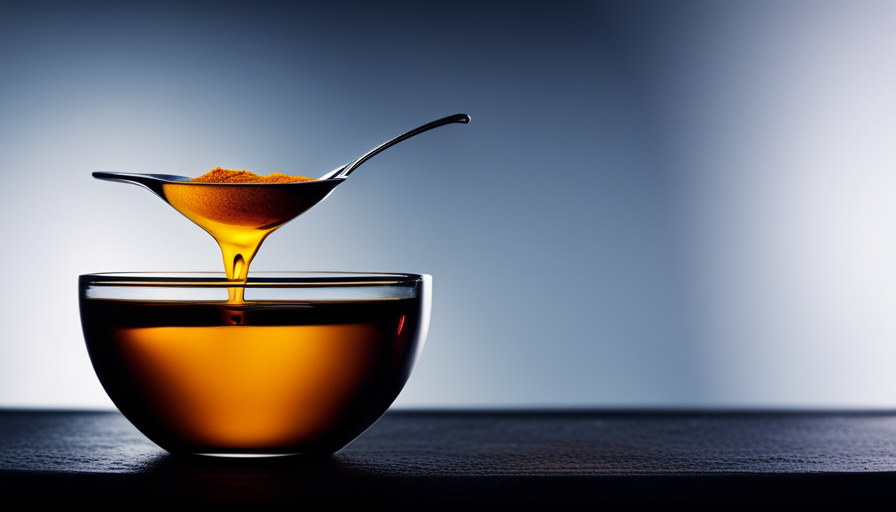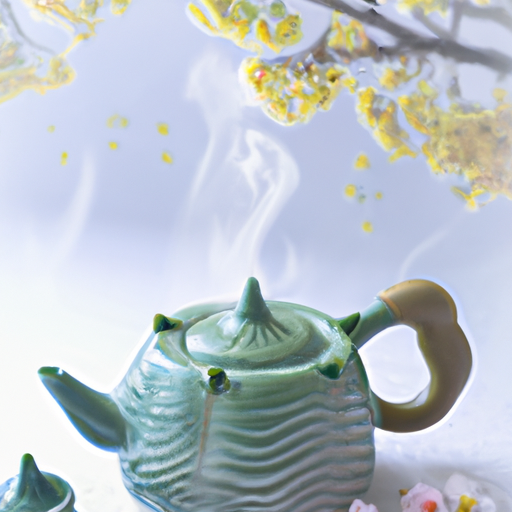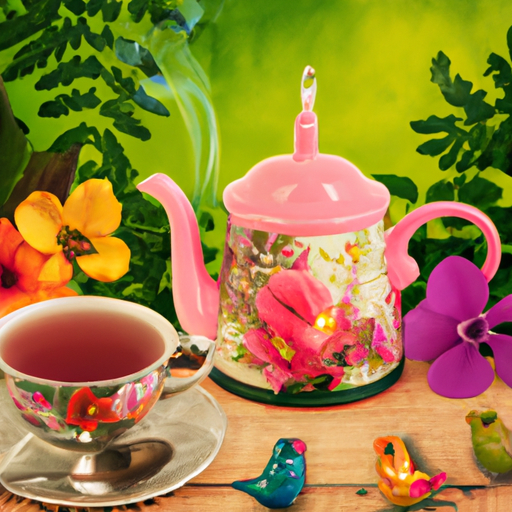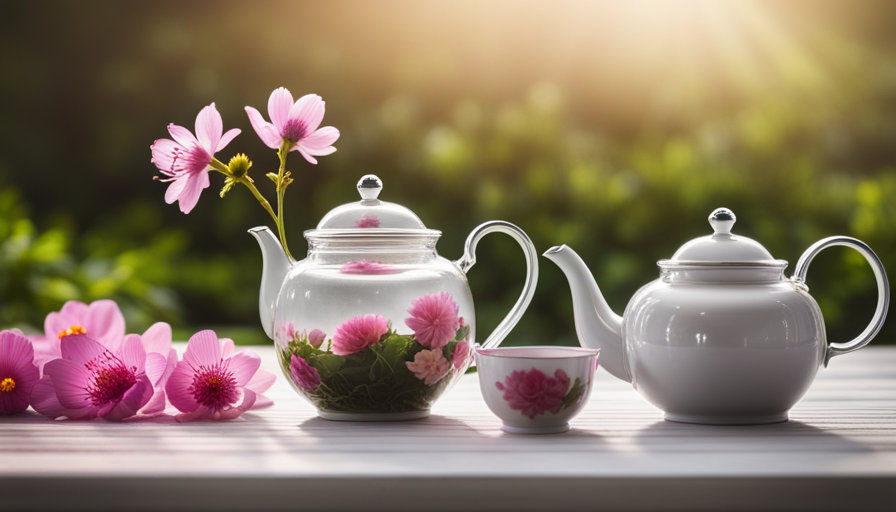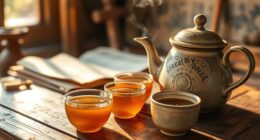Have you ever thought about how to transform lovely flowers into a delightful and calming drink? Well, I’m here to reveal the secrets of crafting flower tea. Surprisingly, flowers have been utilized for many years in different cultures to produce fragrant and flavorful teas that provide a variety of health advantages.
From calming chamomile to vibrant hibiscus, the possibilities are endless.
In this article, I will guide you through the fascinating process of choosing the right flowers, preparing them for tea, and blending them to create unique flavor profiles. I’ll also share brewing techniques and tips for enhancing the flavor of your flower tea.
Additionally, we will explore the diverse world of flower varieties and their specific health benefits. And if you’re feeling adventurous, I’ll even show you how to incorporate flower tea into your culinary creations.
So, get ready to embark on a floral journey and unlock the wonders of flower tea. Your taste buds and well-being will thank you!
Key Takeaways
- Choose the right flowers for taste and aroma.
- Properly dry flowers before steeping.
- Consider the medicinal properties of flowers before use.
- Experiment with brewing techniques to find the perfect balance.
Choosing the Right Flowers
Choosing the right flowers is essential for creating a mesmerizing floral tea that’ll transport your senses to a blooming garden oasis. When it comes to making flower tea, the type of flowers you choose can greatly impact the taste and aroma of the final brew.
Not all flowers are suitable for tea, so it’s important to select the ones that are safe and flavorful.
Firstly, consider the drying techniques for the flowers. Most flowers used for tea need to be dried before they can be steeped. Air drying is a common method that helps preserve the flowers’ natural flavors and medicinal properties. By hanging the flowers upside down in a cool, dark place, you can ensure that they retain their vibrant colors and delicate fragrance.
Furthermore, it’s crucial to research the medicinal properties of the flowers you plan to use. Some flowers, like chamomile and lavender, are known for their calming effects, while others, such as hibiscus and rose, have antioxidant properties. Understanding the health benefits of different flowers will not only enhance your tea-drinking experience but also allow you to choose flowers that align with your personal wellness goals.
Now that you’ve chosen the right flowers and learned about their drying techniques and medicinal properties, it’s time to move on to preparing the flowers for brewing.
Preparing the Flowers
When preparing flowers for tea, it’s important to start by harvesting them at the right time. This ensures that they’re at their peak flavor and quality.
After harvesting, the flowers should be properly dried to preserve their flavor and prevent spoilage. Additionally, it’s important to remove any stems or leaves from the flowers before using them in tea, as these parts can have a bitter taste.
Harvesting and Drying the Flowers
Once the flowers have bloomed, it’s time to pick them, like plucking the ripest fruit from a tree. Harvesting techniques are crucial to ensure the flowers are picked at their peak. Gently grasp the stem near the base and pull upwards, being careful not to damage the delicate petals. To maintain the flowers’ quality, it’s best to harvest them in the morning when the dew has dried but before the sun becomes too intense. After harvesting, it’s important to dry the flowers properly to preserve their flavor and aroma. There are various drying methods available, including air drying, oven drying, and using a dehydrator. Each method has its own advantages and it’s important to choose the one that suits your needs. Once the flowers are dried, the next step is removing any stems or leaves, preparing them for the next phase of tea-making.
Removing any Stems or Leaves
To ensure a refined and aromatic brew, carefully pluck away any remaining stems or leaves from the dried flowers. This step is crucial in achieving the perfect cup of flower tea. Removing the stems and leaves allows the focus to be solely on the delicate flavors and scents of the flowers.
Here are some proper techniques for steeping flower tea:
- Use freshly boiled water to extract the full essence of the flowers.
- Steep the flowers for about 5-7 minutes to release their flavors.
- Adjust the steeping time based on personal preference for a stronger or milder brew.
Infusing flower tea with other flavors can create a delightful twist. Consider adding a hint of citrus zest, a touch of honey, or even a sprinkle of dried herbs to enhance the floral notes.
With the flowers now free of any unwanted elements, let’s move on to the next section on blending the flowers for a truly unique flower tea experience.
Blending the Flowers
After carefully selecting a variety of vibrant petals, I start blending the flowers together to create a visually stunning and fragrant mix for my flower tea. Blending techniques are essential to ensure that the flavors and medicinal properties of each flower are properly extracted.
I gently crush the flowers using a mortar and pestle, taking care not to overdo it and risk losing the delicate aromas. This method allows the petals to release their natural oils, resulting in a more flavorful and aromatic tea.
When choosing flowers for blending, it’s important to consider their individual medicinal properties. For example, chamomile flowers are known for their calming effects, while lavender flowers promote relaxation and stress relief. By combining different flowers, I can create a tea that not only tastes delicious but also provides various health benefits.
Transitioning into the next section about brewing techniques, I carefully transfer the blended flower mix into a teapot, ready for the next step in creating the perfect flower tea.
Brewing Techniques
As you pour hot water over the blend of crushed flowers in the teapot, you watch as the petals dance and swirl, releasing their vibrant colors and fragrant aromas. The brewing process is crucial to ensure a perfect cup of flower tea.
Here are some brewing techniques to follow:
-
Brewing time: The duration of steeping the flowers directly impacts the taste and strength of the tea. For a delicate floral flavor, steep the flowers for 3-5 minutes. If you prefer a stronger taste, extend the brewing time to 7-10 minutes.
-
Water temperature: Different flowers require specific water temperatures for optimal flavor extraction. Generally, use water that’s around 180°F (82°C) for most flower teas. However, some delicate flowers, like chamomile, require lower temperatures around 160°F (71°C) to prevent bitterness.
-
Patience is key: Allow the flowers to infuse the water slowly. Avoid rushing the process, as it can result in a weaker flavor. Take your time and let the flowers work their magic.
-
Experiment: Don’t be afraid to experiment with brewing techniques. Adjust the brewing time and water temperature according to your taste preferences. Discovering the perfect balance will enhance the flavors and aromas of your flower tea.
By brewing the flowers with care and precision, you lay the foundation for a delightful cup of tea.
Next, we’ll explore how to further enhance the flavor of flower tea without adding any additional steps.
Enhancing the Flavor
After discussing the various brewing techniques, let’s now delve into enhancing the flavor of your flower tea. This step is crucial as it not only elevates the taste but also adds a delightful aroma to your tea. There are numerous ways to achieve this, but one effective method is by adding natural sweeteners. By incorporating ingredients such as honey, stevia, or agave syrup, you can enhance the natural sweetness of the flowers and create a more balanced and enjoyable flavor profile.
To help you choose the perfect natural sweetener for your flower tea, refer to the table below:
| Sweetener | Flavor Profile | Best Flower Tea Pairing |
|---|---|---|
| Honey | Rich, floral | Chamomile, lavender |
| Stevia | Mild, herbal | Rose, hibiscus |
| Agave syrup | Sweet, caramel | Chrysanthemum, jasmine |
Experimenting with different sweeteners can be a delightful journey of discovery and personal preference. Once you have enhanced the aroma and flavor of your flower tea, it’s time to move on to the next step: serving and enjoying.
Serving and Enjoying
To fully savor the delightful experience of the blooming infusion, indulge in the art of presentation and relish every sip. Flower tea not only offers a range of health benefits, but it also provides an opportunity to engage in beautiful rituals that enhance the overall tea-drinking experience.
When serving flower tea, it’s important to choose an elegant tea set that complements the delicate beauty of the blooms. Use a glass teapot or teacup to showcase the vibrant colors and graceful shapes of the flowers as they unfurl in hot water. This visual display adds to the enjoyment of the tea and creates a sense of tranquility.
As you pour the tea, take a moment to appreciate the enticing aroma that wafts from the petals. Inhale deeply and let the fragrance transport you to a serene state of mind. Sip the tea slowly, allowing the flavors to linger on your palate. Each sip offers a new dimension of taste, making the experience truly enchanting.
Flower tea rituals can be further enhanced by pairing them with light snacks or desserts that complement the floral flavors. This combination creates a harmonious balance of tastes and textures, elevating the overall enjoyment of the tea.
To explore different flower varieties and expand your tea-drinking repertoire, let’s delve into the fascinating world of flower tea blends…
Exploring Different Flower Varieties
After serving and enjoying flower tea, it’s time to delve into the fascinating world of exploring different flower varieties. Each flower brings its unique flavors and aromas, making the experience of floral tea even more delightful.
Here are four flower varieties that can elevate your floral tea party to new heights:
-
Rose: Known for its sweet and fragrant petals, rose tea adds a romantic touch to any occasion. Its delicate flavor pairs well with black or green tea.
-
Chamomile: With its calming properties, chamomile flowers create a soothing and gentle tea. It’s perfect for relaxation and unwinding after a long day.
-
Lavender: Adding a floral and slightly herbaceous taste, lavender flowers lend a calming aroma to your tea. It pairs well with chamomile or mint for a refreshing blend.
-
Hibiscus: Vibrant and tart, hibiscus flowers create a bright red tea with a tangy flavor. It can be enjoyed hot or cold, and its natural acidity makes it a great base for fruity tea blends.
With these different flower arrangements, you can create a diverse selection of floral teas for your guests to enjoy. Now, let’s move on to understanding the health benefits of flower tea.
Understanding the Health Benefits
Delving into the world of floral teas unveils a multitude of health benefits that can transport you to a state of wellness and vitality. Understanding the research behind flower tea’s health benefits is essential to fully appreciate its potential impact on your well-being.
Research suggests that flower teas are rich in antioxidants, which help combat free radicals and reduce the risk of chronic diseases. Additionally, certain flower varieties, such as chamomile and hibiscus, have been found to have anti-inflammatory properties that can soothe digestive issues and promote heart health. Moreover, flower teas like lavender and rose can improve sleep quality and reduce anxiety, offering a calming effect on the mind and body.
To better understand the various health benefits of flower tea, take a look at the table below:
| Flower Variety | Health Benefit |
|---|---|
| Chamomile | Soothes digestive issues |
| Hibiscus | Promotes heart health |
| Lavender | Improves sleep quality |
| Rose | Reduces anxiety |
While flower tea offers numerous health benefits, it’s important to be aware of potential side effects. Some individuals may experience allergic reactions, so it’s crucial to start with small amounts and monitor your body’s response. Additionally, certain flower teas may interact with medications, so it’s advisable to consult with a healthcare professional before incorporating them into your routine.
Now that you understand the research and potential side effects, let’s explore the next step in enjoying flower tea: storing and preserving it for long-lasting freshness.
Storing and Preserving Flower Tea
Now that you’ve learned about the health benefits of floral teas, let’s talk about how to store and keep them fresh for a longer period of time. Proper storage and preservation techniques are essential to maintain the flavor, aroma, and medicinal properties of flower tea. The key to preserving flower tea lies in protecting it from air, light, moisture, and heat.
To store your flower tea, it’s important to choose the right storage containers. Opt for airtight containers made of glass or ceramic, as these materials help to retain the tea’s freshness and prevent moisture buildup. Avoid using plastic containers, as they can affect the taste and quality of the tea.
When storing flower tea, keep it away from direct sunlight and extreme temperatures. Store it in a cool, dark place, such as a pantry or cupboard. Avoid placing it near spices or strong-smelling foods, as flower tea can easily absorb odors.
To further extend the shelf life of your flower tea, consider vacuum-sealing it or using oxygen absorbers to remove any excess air. This will help to maintain its freshness for a longer period of time.
By following these storing and preserving techniques, you can enjoy the delightful flavors and health benefits of flower tea for an extended period. Now, let’s transition into the subsequent section about experimenting with flower tea in culinary creations.
Experimenting with Flower Tea in Culinary Creations
Let’s explore the exciting world of culinary creations using flower tea, where flavors come alive and taste buds dance with delight. Did you know that incorporating floral infusions into dishes has become a popular trend, with a 50% increase in floral tea-inspired recipes being shared online?
When it comes to culinary experiments, flower tea opens up a whole new realm of possibilities. Its unique flavors can elevate both sweet and savory dishes, adding a touch of elegance and intrigue.
Here are three ways you can incorporate flower tea into your culinary creations:
-
Infused Oils and Vinegars: By steeping flower tea in oils or vinegars, you can impart delicate floral notes to dressings, marinades, and sauces. Try infusing olive oil with chamomile tea for a soothing and aromatic salad dressing.
-
Baked Goods: Add a twist to your favorite baked goods by incorporating flower tea. Replace water or milk in recipes with brewed flower tea for a subtle yet distinct flavor. For example, lavender-infused cupcakes offer a fragrant and unique twist to a classic treat.
-
Cocktails and Mocktails: Flower tea can also be a delightful addition to your favorite beverages. Create floral-infused syrups or use brewed flower tea as a base for refreshing cocktails or mocktails. Hibiscus tea mixed with sparkling water and a splash of lemon makes for a vibrant and refreshing summer drink.
With these culinary experiments, you can explore the unique flavors that flower tea has to offer and create unforgettable dishes that will impress your friends and family. So go ahead, let your creativity bloom in the kitchen!
Frequently Asked Questions
Can I use any type of flower to make flower tea?
Yes, you can use various types of flowers to make flower tea. Some common flowers suitable for making tea include chamomile, rose, lavender, and hibiscus.
It’s important to properly dry the flowers before making tea to enhance their flavor and preserve their natural properties. To do so, you can hang the flowers upside down in a cool, dark place until they’re completely dry.
How long should I steep the flowers for maximum flavor?
To steep flowers for maximum flavor, it’s crucial to follow the proper technique. First, select the best types of flowers for making tea, like chamomile, lavender, or rose petals.
Next, bring water to a boil and pour it over the flowers in a teapot. Let them steep for about 5-10 minutes, depending on the flower type. This allows the flavors to infuse fully, resulting in a delicious and aromatic cup of flower tea.
Can I mix different types of flowers together when making flower tea?
Yes, you can definitely mix different types of flowers together when making flower tea. By combining different flowers, you can create unique and delightful flavors and aromas in your tea. It’s all about experimenting with various flower blends to find the perfect combination that suits your taste buds. The possibilities are endless, so don’t be afraid to get creative and explore the wonderful world of flower tea blends.
Are there any specific health benefits associated with drinking flower tea?
Drinking flower tea can have various health benefits. It’s known for its effectiveness in reducing anxiety and providing a calming effect on the mind and body. Additionally, flower tea can promote healthy skin due to its antioxidant properties, which help combat free radicals and prevent skin aging. Regular consumption of flower tea can contribute to improving overall well-being and enhancing the natural beauty of your skin.
How long can I store flower tea before it goes bad?
The shelf life of flower tea can vary depending on the type of flowers used and the storage conditions. Generally, flower tea can be stored for up to one year if properly stored. To ensure its freshness, store flower tea in an airtight container in a cool, dark place away from moisture, light, and strong odors. Avoid exposing it to direct sunlight or extreme temperatures.
Following these guidelines will help extend the shelf life of your flower tea.
Conclusion
In conclusion, making flower tea is an art that combines nature’s beauty with the delight of a soothing beverage. By carefully selecting and preparing the flowers, blending them to create unique flavors, and using different brewing techniques, you can unlock a world of sensory pleasure.
Whether you choose to enhance the flavor with honey or lemon, or explore the health benefits of flower tea, the possibilities are endless. So, why not embark on this floral journey and let the petals dance on your taste buds?

